Introduction
Numerous advances in preventive medicine have provided methods for detecting serious chronic diseases which presently threaten our public health. Today's clinician must direct his efforts to the “gray” areas of undiagnosed asymptomatic disease as well as to the treatment of existing disease. The early detection of subclinical disease by advanced screening procedures is making considerable progress in the field of preventive medicine to reduce the nonstop progression of certain chronic diseases. The field of periodontal medicine can also help in early detection of certain chronic systemic diseases like diabetes mellitus in a more easy and simplified manner1. Diabetes mellitus is undiagnosed in approximately 1/2 of the patients actually suffering from the disease. The prevalence of DM patients is more than 2 times as high in patients with periodontitis when compared to periodontally healthy patients. Thus, a high number of patients with periodontitis may have undiagnosed DM3.
The ability to collect gingival crevicular blood (GCB) for glucose measurement using readily available glucometers that measure glucose in a few seconds seems to be a good method of screening diabetic patients. Several studies3,4,6,7,8 in the past have reported significant correlation between GCB & CFB (capillary finger-stick blood) but few fail to accept this correlation5. So, the aim of our study is to evaluate the authenticity of use of gingival crevicular blood as an early indicator of elevated systemic blood glucose levels in diabetes mellitus patients.
Materials And Method
For this study, subjects were selected randomly from the general OPD of the Department of Periodontics, Government Dental College & Hospital, Amritsar, Punjab. The study was performed randomly on a total of fifty patients including 26 males and 24 females with evident bleeding on probing.
 | Image 1- One Touch Ultra 2 Glucometer
 |
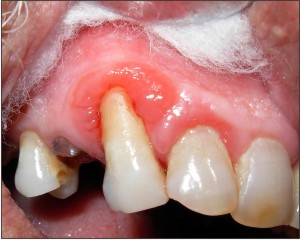 | Image 2 - Isolation Of Site For Gingival Crevicular Blood Collection.
 |
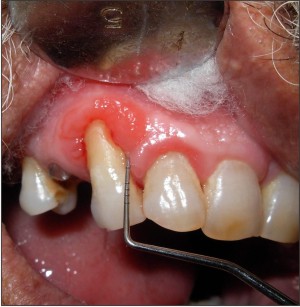 | Image 3 - Probing To Induce Gingival Bleeding.
 |
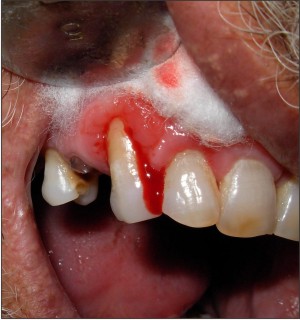 | Image 4 - Bleeding On Probing
 |
 | Image 5 - Method Of Inducing Finger Prick Capillary Bleed.
 |
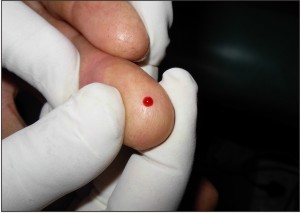 | Image 6 - Finger Prick Capillary Blood Elicited.
 |
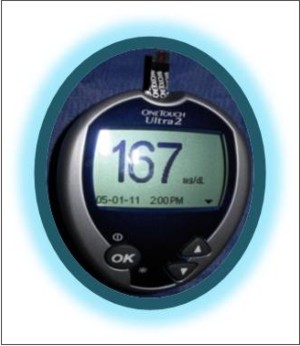 | Image 7 - Glucometer Showing Blood Glucose Reading.
 |
The following criteria were considered for the selection of subjects:
Selection Criteria
1. Patients with evident bleeding on probing.
Exclusion Criteria
1. Patients with requirement for antibiotic premedication.
2. Patients with disorder that was accompanied by an abnormally low or high haematocrit. For example, Polycythaemia Vera, anaemia, and dialysis.
3. Patients with intake of substances that interfere with the coagulation system for example, Coumarin derivatives, Non-steroidal anti-inflammatory drugs or Heparin.
4. Sites with suppuration.
Periodontal examination included measurement of probing depth, attachment level, and bleeding on probing. A site with more profuse bleeding was chosen for collecting the gingival crevice blood (GCB) sample on the anterior segment of the mouth. The area was isolated with cotton rolls to prevent saliva contamination and dried with compressed air. Probing was repeated until a sufficient amount of blood appeared in the gingival crevice. The one touch ultra 2, Johnson & Johnson was used according to the manufacturer's recommendations. Immediately after measuring glucose levels in GCB, a capillary finger-stick blood (CFB) sample was drawn from the index finger using a disposable sterile lancet.
Statistical analysis using Pearson's correlation coefficient was performed to assess the correlation between the glucose measurements in the gingival blood samples and those obtained by finger puncture. Paired t-test was performed to test the significance of the difference in glucose level between the gingival and finger readings.
Results
The range of the gingival crevicular blood glucose measurements varied from 69mg/dl to 374 mg/dl, with a mean value of 154.7 mg/dl and a standard deviation of 85.77mg/dl.
The range of the finger-prick blood glucose measurements varied from 77 mg/dl to 372 mg/dl, with a mean value of 157.4 mg/dl and a standard deviation of 84.93 mg/dl.
On comparison of gingival crevicular blood glucose and finger-prick blood glucose measurements, finger prick capillary blood glucose showed a higher mean value (157.4 mg/dl) than gingival crevicular blood glucose mean value(154.7 mg/dl) and showed r = 0.988; p < 0.001, thus giving statistically significant results.
On analysis of the glucose measurements of the randomly included 50 patients, 23 patients were found to be diabetic and 27 patients were non diabetic. And surprisingly, only 15 patients out of the 23 diagnosed to be diabetic by our measurements were aware of their diabetic status. The diabetic status of the unaware 8 patients was further confirmed by intravenous laboratory method of glucose measurement which is considered as the gold standard for blood glucose measurements.
The patients were further divided into two groups-
Group I- Diabetic group (n=23) and Group II- Non-Diabetic group (n=27) and intra group analysis was done.
On comparison of gingival crevicular blood glucose and finger-prick blood glucose measurements of Group I patients, the Pearson's correlation coefficient showed r-value = 0.977 and a P-level <0.001.
On comparison of gingival crevicular blood glucose measurements and finger-prick blood glucose measurements of the Group II patients, the Pearson's correlation coefficient showed r-value = 0.875 and a P-level of <0.001.
Discussion
Since periodontal inflammation with or without complication factor of DM is known to produce ample extravasate of blood during diagnostic periodontal examination (Ervasti 1985)2 no extra procedure, e.g. finger puncture with a sharp lancet is necessary to obtain blood for glucometric analysis. Even in the case of very low gingival crevicular bleeding, a glucose measurement is possible with the use of self monitoring device (Ultra Touch 2, Johnson & Johnson), due to the low amount of blood necessary to perform the analysis. Moreover, the technique described is more familiar and less traumatic to the patient than a finger puncture4.
The strong correlation obtained in the present study on comparison between the various blood glucose measurements indicates the feasibility of using periodontal sulcular blood as an alternative to the FP blood in accordance to the previous studies. On analysis of our study, finger prick capillary blood glucose showed a slightly higher mean value than gingival crevicular blood glucose mean value, may be due to contamination of GCF which dilutes the glucose concentration producing lower measurements in GCB.
Conclusion
Within the limitations of this study, the following conclusion can be made that GCB collected during diagnostic periodontal examination may be an excellent source of blood for glucometric analysis. The technique is safe, easy to perform, and comfortable for the patient and therefore, helps to increase the frequency of
diagnosing diabetes during routine periodontal therapy which provides a more
objective indicator for referral to physicians than traditional methods. Thus, the
dentist may increase his importance as a member of the health team by participating in the search for undiagnosed asymptomatic DM.
References
1. Stein GM, Nebbia AA. A chairside method of diabetic screening with gingival blood. Oral Surg Oral Med Oral Pathol 1969; 27: 607-612.
2. Ervasti T, Knuuttila M, Pohjamo L, Haukipuro K. Relation between control of diabetes and gingival bleeding. J Periodontol 1985; 56: 154-57.
3. Parker RC, Repley JW, Isley W. Gingival Crevicular Blood for assessment of blood glucose in diabetic patients. J Periodontal 1993; 64: 666-672.
4. Beikler T, Kuczek A, Petersilka G, Flemming TF. In-dental-office screening for diabetes mellitus using gingival crevicular blood. J Clin Periodontol 2002; 29: 216-218.
5. Muller HP, Behbehani E. Methods for measuring agreement: glucose levels in gingival crevice blood. Clin Oral Invest 2005; 9: 65-69.
6. Khader YS, Judeh A, Rayyan M. Screening for type 2 diabetes mellitus using gingival crevicular blood. Int J Dent Hygiene 2006; 4: 179-182.
7. Ardakani MR, Moeintaghavi A, Haerian A, Ardakani MA. Correlation between levels of sulcular and capillary blood glucose. J Contemp Dent Pract. 2009; 10: 10-17.
8. Strauss SM, Wheeler AJ, Russell SL, Gluzman R. The Potential use of gingival crevicular blood for measuring glucose to screen for diabetes: An Examination based on characteristics of the blood collection site. J Periodontal 2009; 80: 907-914. |